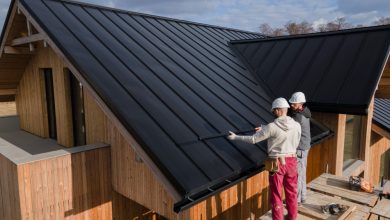Waterproof Plywood: What You Need to Know

Plywood’s properties are widely recognised. It’s been used for a variety of purposes for a long time, and the simple substance continues to thrive due to the intrinsic features it possesses. Despite this, one of the most frequently asked questions about plywood is its water resistance quality. Is plywood waterproof? Can plywood be used efficiently to make furniture for places with higher water inflows? These are legitimate concerns since, as we all know, plywood is made of wood veneer, and when the wood is exposed to water for an extended length of time, it can suffer from damage and warping.
However, waterproofing is required for plywood to be utilised effectively in interior areas such as bathrooms, kitchens, patios, and so on. There is no other way out, especially in high-moisture conditions. A waterproof ply board is an absolute necessity.
Let’s take a look at things to know and the different types of waterproof plywood before you get waterproof plywood:
Table of Contents
Different Types of Waterproof Plywood
-
Moisture Resistant Plywood (MR Plywood)
MR grade plywood is ideal for interior applications such as the bedroom, living room, or study space. It is important to remember that MR grade is not a waterproof ply board. It is coated with resins such as formaldehyde to tolerate humidity and moisture. However, it cannot endure excessive water ingress. To elaborate, it is appropriate for household and workplace furniture, as well as other functions like shelving. This would not be appropriate in the long run if there are spots that are prone to getting wet often, such as kitchen shelves.
-
Boiling Water Resistant Plywood (BWR Plywood)
This is used both indoors and outside and is coated with phenolic resins to make it weather resistant. Unlike MR grade plywood, BWR grade plywood is suitable for usage in locations that will be exposed to water for an extended period of time, such as kitchens and bathrooms. It is also appropriate for areas with high humidity or rain. The BWR grade plywood will last longer, and the furniture pieces built from it will appear as nice as the day they were made.
It should be emphasised, however, that the BWR grade ply board is water-resistant rather than waterproof. It can hold water for extended periods of time and is best suited for internal use.
-
Boiling Waterproof Plywood (BWP Plywood)
BWP plywood, often known as Marine Plywood, is entirely waterproof. Because it is made entirely of waterproof ply board, it is incredibly adaptable and long-lasting. BWR grade plywood can be used to construct anything your imagination can conjure up. This simple material’s form remains unaffected by water. Furthermore, because it is impermeable to water, as the name implies, this plywood is used for a variety of maritime operations, including boat construction.
What makes this plywood so adaptable? Its exceptional qualities are due to the high grade of the veneers utilised, mixed with undiluted resins. To maintain the standard and get verifiable certificates, some quality checks for this type of plywood entail immersing a sample in boiling water for three days and then evaluating the plywood on the basis of strength and other attributes.
Facts About Waterproof Plywood
You may make an informed decision now that you’re aware of the varied water-resistance capabilities of plywood. The first consideration should be the purpose and placement of the plyboard. You now have a good idea of how much water comes into contact with the plywood, how long the water stays there, how durable you want your plywood to be, and any other question that comes to mind to select the finest from the large choice of quality plywood easily available to you.
Moisture Resistant Plywood is made from wood veneers joined along and across the grain using urea-formaldehyde glue and pressed at a predetermined temperature and pressure using a hot press. This is known as MR or commercial plywood. MR plywood is often employed in dry environments or indoor applications where there is no threat of water or moisture. Following the application of MR Plywood, there is a release of formalin-generated fumes that are dangerous to health and carcinogenic in nature.
But can the excess water cause fungus? You may be wondering how it affects plywood. Fungal spores require oxygen and nutrients to survive, which are abundant in wood in the form of cellulose, while oxygen may be obtained from the air. Fungus is a source of nutrition for termites, and its presence may be detected quickly.
Summing Up
Finally, manufactured plywood is not immediately watertight. They are truly water-resistant, depending on the glue used to make the specific grade.
People frequently believe that because there are existing waterproof plywood, normal plywood cannot be modified to become waterproof. This, however, is not the case. Commercial and residential plywood may be made water-resistant in a few easy ways. Waterproofing paint, oils, and varnish are popular methods for preventing water damage to plywood. Furthermore, these procedures can help to avoid rot, warping, and splitting in wood.




